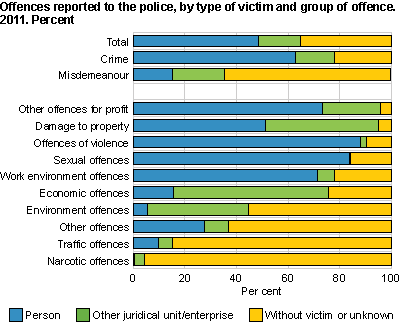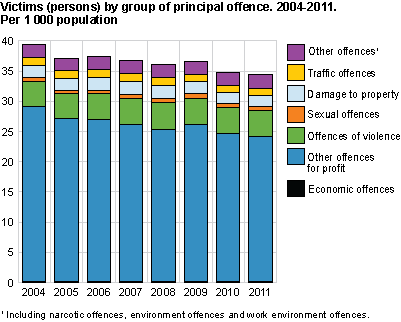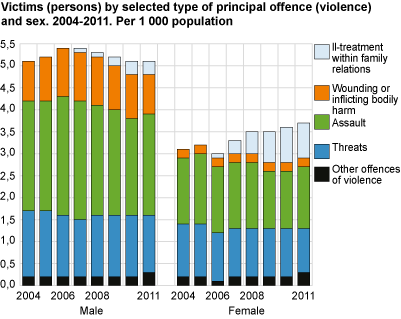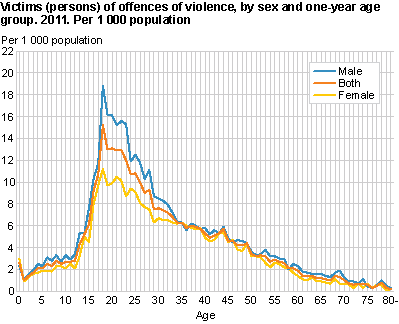Content
Published:
This is an archived release.
Fewer offences against enterprises
A total of 170 000 persons were registered as victims of offences reported to the police in 2011. This is approximately the same number of persons as the year before, however the types of offences the population report to be victims of are changing. Furthermore, the number of offences against enterprises was significantly reduced during the period 2009-2011.
Of the 380 000 offences reported to the police in 2011, 184 000 of them had a person registered as the victim, whilst enterprises and other juridical units were reported to be the victims of 63 000 offences. Additionally, many offences do not inflict a direct experience of victimisation, and 133 000 offences were filed by the police without a registered victim, of which two thirds were narcotic or traffic offences. Persons are registered as the victims of a significant number of offences for profit (73.5 per cent), sexual offences (84 per cent) and offences of violence (88 per cent). Enterprises are, on the other hand, registered as the victims of many of the economic offences (60 per cent) and offences concerning damage to property (44 per cent).
Enterprises victims of fewer offences for profit and damage to property
In total, 2011 saw about 5 800 fewer offences committed against enterprises compared with 2010. Enterprises were registered as the victims of 38 700 offences for profit; almost 4 800 less than the previous year and close to 8 600 fewer than in 2009. Over the span of these two years, a decline is registered in most kinds of theft and other offences for profit against enterprises. Furthermore, enterprises were the victims of 8 500 occurrences of damage to property in 2011; a decrease of 28 per cent compared with 2009.
Offences for profit still mainly victimise persons
When taking into account the growth of population, the victimisation level for persons is at its lowest level since 2004 - the year these crime statistics were introduced. This decreasing level of victimisation correlates mainly with the overall decline in registered offences for profit, a trend dating even further back than 2004 (see statistics for Offences reported to the police ). Out of all persons victimised in 2011, 69 per cent were registered as a victim at least once for theft or other offences for profit as the principal offence. The corresponding share in 2004 was 74.
Fewer victims of theft at home ...
A total of 119 000 persons were registered as victims of just over 126 000 offences for profit in 2011, close to the registered level in 2010. Derived from the principal offence, a total of 36 500 persons were registered as victims of simple and aggravated larcenies from houses, dwellings or motor vehicles - 4 600 fewer than the year before. The number of persons victimised for these kinds of thefts in 2011 is as much as 9 400, or 20 per cent, lower than in 2009.
... but more in public places, particularly in Oslo
Within the principal offences, almost 19 400 persons were victims of aggravated larceny in public places in 2011. This entails no less than 4 700, or 32 per cent, more than the previous year. In 2011, nearly three out of four of these aggravated larcenies in public places were committed in Oslo, thus representing nearly all of the nationwide increase in this type of offence. Furthermore, this particular, significant increase affected the total number of offences for profit, thereby contradicting the otherwise downwards trend within this group of offence.
Of all persons as victims of other offences for profit, nearly 24 per cent were registered with an Oslo residence. In 2011, 4.6 per cent of the population in Oslo was registered as victims of at least one offence for profit, with the age group 20-29 standing out with a percentage of 7.8. Nationwide, the county populations of Sogn og Fjordane (1.2 per cent), Nordland (1.4 per cent) and Møre og Romsdal (1.4 per cent) are least exposed to theft and other kinds of offences for profit.
More victims of violent offences in 2011
With regard to the principal offence, 5 800 persons were registered as victims of threats in 2011. Additionally, nearly 15 500 different persons were victims of physical violence at least once (incorporating ill-treatment in family relations and crimes of violence against the person). Overall, the 23 300 persons registered as victims of offences of violence represent an increase of nearly 1 000 persons compared with 2010. A large proportion of this increase can be attributed to the events of 22 July 2011 (see text box).
Continued increase in victims of ill-treatment in family relations
With regard to the principal offence in 2011, 2 810 different persons were victims of ill-treatment in family relations (including serious ill-treatment), marking a 10 per cent increase from 2010. This increase is not as large as in previous years - percentage wise - since the 2006 implementation of criminal law regulating ill-treatment in family relations. The major increase during the time span 2006-2011 is partly due to a change in the registration methods regarding violent crime reported to the police (see also statistics for Offences reported to the police, 2011 ). It is, however, also due to an actual increase in the number of reported violent offences - mainly relating to victimised women and children.
Male youths most at risk, but not for all offences of violence
Out of all persons registered as victims of offences of violence in 2011, approximately half were in the age group 10-29 years. Furthermore, males within the age span of 18-23 years saw the highest frequency of violent victimisation, ranging from 15 to 19 victims of offences of violence per 1 000 population.
In 2011, 58 per cent of the victims of offences of violence were male. As in previous years, the male domination within certain types of offences of violence was significant. With regard to the principal offence, males represented the vast majority of victims of wounding or inflicting bodily harm (85 per cent) and assault (62 per cent). An equally high proportion of females, on the other hand, were the victims of ill-treatment in family relations (73 per cent). Additionally, within sexual offences, females constitute an even larger proportion of the victims (87 per cent).
In 2011, nearly half of all the victims of ill-treatment in family relations were under the age of 20 years. Nine out of ten males with this offence registered as their principal offence were in this age group. The age range among females was much wider, and in 2011 nearly two thirds of the female victims of ill-treatment in family relations were 20 years old or older.
More children and youths in the violent crime statistics for 2011
From 2010 to 2011, quite a significant increase was registered in the total number of victims within the youngest age groups. For the age group 0-9 years, the increase is connected to the increase of just over 300 victims of ill-treatment in family relations, compared with the year before. However, about one third of this isolated increase can be attributed to a modification in Statistics Norway’s method of age calculation (see text box). Furthermore, the age span 16 to 19 years experienced a relatively large increase of registered victims of violent offences. These particular figures incorporate many of the murders and attempted murders committed on the island of Utøya on 22 July 2011. In total, these offences correspond to nearly the full increase registered for this age group (see text box). The remaining age groups saw only minor changes from 2010 to 2011 in the number victims of offences of violence.
Victims of offences, reported to the police, 2011
Revision of murder cases, including the events of 22 July 2011:During the processing of the 2011 figures, Statistics Norway has expanded the regular revision of murder cases (see About the statistics ) to also include the events of 22 July 2011 (also see text box in Offences reported to the police, 2011 ). As a result, these statistics include a total of 1 017 persons as victims of the offences committed in Oslo city centre and on the island of Utøya on 22 July 2011. A total of 486 persons are registered as victims of attempted murder and 77 persons as victims of murder. In the statistics, these victims are included in Offences of violence as group of offence. Furthermore, a total of 446 persons are registered as victims of Crime involving public danger (bombing). These are included in Other offences as the group of offence, and Crime involving public danger (Other) in the statistics categorising from type of offence. Additionally, there are 8 persons and 4 enterprises registered as victims of Damage to property.
Modification of Statistics Norway’s method of age calculation for ill-treatment in family relations:Due to specific legislation and registration methods, some children are incorporated into criminal cases where ill-treatment in family relations has begun prior to the birth of the child. In the statistics, these children were formerly counted as having an unknown age, but from 2011 these children’s ages will be set to 0 years. For the current year, this modification of age calculation has resulted in some 90 more victims with age 0 years, and a corresponding decrease in the unknown age group. This modification also marks a clear break in time series for some statistics (see also figure in text), and thus must be taken into consideration when interpreting the development of the youngest children. |
The statistics on victims of offences reported to the police are developed, produced and published on behalf of the Ministry of Justice and Public Security and the Police. More on sampling, definitions and sources of error is available in About the statistics . See also Statistics Norway’s Survey of level of living, victimisation and fear of crime and enterprises’ victimisation in economic crimes in Ellingsen 2010 . The statistics, with comparable time series and more tables, are also available in StatBank Norway . |
Tables:
- Table 1 Offences reported to the police, by type of victim, category of offence and group of offence. 2011. Absolute figures
- Table 2 Victims (persons), by number of offences, sex and age. 2011. Absolute figures and per cent
- Table 3 Victims (persons), by sex, age and place of residence (county). 2011. Absolute figures and per 1 000 population
- Table 4 Victims (persons), by category of offence, group of principal offence, sex and age. 2011. Absolute figures and per 1 000 population
- Table 5 Victims (persons), by category of offence, group of principal offence and one-year age group. 2011. Absolute figures
- Table 6 Victims (persons), by category of offence, group of principal offence and one-year age group. 2011. Per 1 000 population
- Table 7 Victims (persons), by category of offence, group of principal offence and place of residence (county). 2011. Absolute figures and per 1 000 population
- Table 8 Victims (persons), by sex, age and type of principal offence. 2011. Absolute figures
- Table 9 Victims (persons) of other offences for profit, by sex and one-year age group. 2011. Absolute figures and per 1 000 population
- Table 10 Victims (persons) of offences for profit, by sex, age and place of residence (county). 2011. Absolute figures and per 1 000 population
- Table 11 Victims (persons) of offences for profit, by number of offences for profit, sex and age. 2011. Absolute figures and per cent
- Table 12 Victims (persons) of offences of violence, by sex and one-year age group. 2011. Absolute figures and per 1 000 population
- Table 13 Victims (persons) of offences of violence, by sex, age and place of residence (county). 2011. Absolute figures and per 1 000 population
- Table 14 Victims (persons) of offences of violence, by number of offences of violence, sex and age. 2011. Absolute figures and per cent
The statistics is now published as Offences and victims reported to the police.
Contact
-
Statistics Norway's Information Centre
E-mail: informasjon@ssb.no
tel.: (+47) 21 09 46 42




